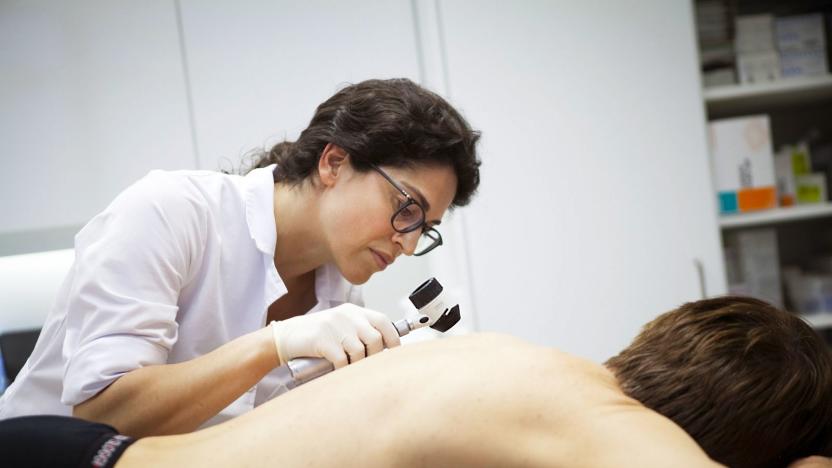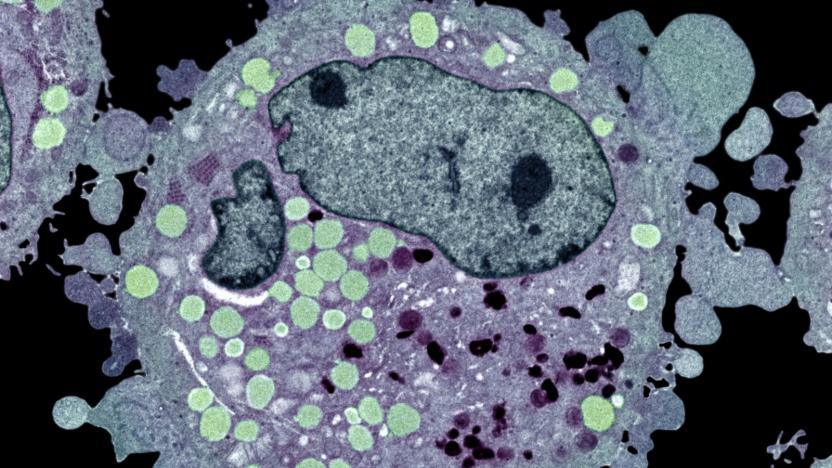skincancer
Latest

AI outperforms human doctors in spotting skin cancer
In January last year scientists reported that artificial intelligence was almost as effective at identifying skin cancer as dermatologists. Now, less than 18 months later, it's even better. In an experiment between a deep learning convolutional neural network (or CNN) and 58 dermatologists, researchers found that human dermatologists accurately identified 86.6 percent of skin cancers from a range of images, compared to 95 percent for the CNN.

AI is nearly as good as humans at identifying skin cancer
If you're worried about the possibility of skin cancer, you might not have to depend solely on the keen eye of a dermatologist to spot signs of trouble. Stanford researchers (including tech luminary Sebastian Thrun) have discovered that a deep learning algorithm is about as effective as humans at identifying skin cancer. By training an existing Google image recognition algorithm using over 130,000 photos of skin lesions representing 2,000 diseases, the team made an AI system that could detect both different cancers and benign lesions with uncanny accuracy. In early tests, its performance was "at least" 91 percent as good as a hypothetically flawless system.

23andMe helps identify genetic links to common skin cancer
The team at 23andMe is clearly going out of its way to show that huge amounts of volunteered genetic data can boost medical research. Scientists at both 23andMe and Stanford used data from consenting customers to conduct the largest ever genetic study of basal cell carcinoma, the most typical form of skin cancer, and made numerous discoveries. They found 14 previously unidentified genetic associations with the cancer, some of which might pinpoint when you're at increased risk. Some gene regions linked to basal cell carcinoma have a larger effect on the young, hinting that environmental factors might play a greater role in getting the cancer as you age. Also, a gene marker's interactions suggest that your risk goes up when you have black or brown hair, and gene areas that maintain telomeres (chromosome ends) played their own part.

Handyscope attachment turns your iPhone into a dermatoscope, no residency required
Just think -- a decade from now, you won't even need to spend eight grueling years in the books to be able to practice medicine. Instead, you'll be able to drop endless cash on smartphone attachments while letting the robots handle the rest. FotoFinder Systems is one company working hard to make that future a reality, with its recently updated Handyscope iOS app working in conjunction with the camera attachment shown above. To do what, you say? To turn your iPhone 3GS or iPhone 4 into a digital dermatoscope for mobile skin examination. It'll probably make quite a few stomachs turn, but the peripheral + app combo allows mere mortals to take dermoscopic photos which can be viewed with a magnification of up to 20X, enabling users to email them directly to their physician (Dr. Spaceman, we hope) for a second opinion. In all seriousness, we can't imagine anyone at risk for skin cancer even waiting for this thing to arrive before going to get checked out, but if you're willing to pay big bucks to play doctor, the attachment is on sale now for €1,166 ($1,582), with the accompanying app going for a comparatively modest $11.99. Vid's after the break, if you're into it.

Lumicure claims to be making progress in using OLEDs to treat skin cancer
The folks at Lumicure have been talking up OLEDs as a potential tool to treat skin cancer for a few years now and, while they still don't exactly have a whole lot to show for themselves, they're now claiming that they're making "excellent progress," and that they actually hope to have a product on the market by the fourth quarter of 2009. That progress is apparently due in large part to the $5 million in funding they received earlier this year although, again, they don't seem to be saying how that money is being put to use. The basic technology, first shown off more than two years ago, consists of a band-aid-type device that's connected to a battery, which lets the patient wear the device all day long, and is apparently more cost-effective and less painful than other methods of treatment. Apparently, the company is so pleased with its progress that it's already starting to focus on its next target: acne.[Via OLED-Info.com, image courtesy LEDs Magazine]

Researchers aim to detect skin cancer via scent
Here's an interesting one. A group of US experts have discovered that a common form of skin cancer could one day be detected very early on by simply analyzing scents. More specifically, it was found that basal cell carcinomas give off an odor that is distinctly different than samples from healthy skin, which obviously opens up the possibility for "cheap and painless testing." In the future, researchers are hoping to create scent profiles for other types of skin cancer, including the infamous malignant melanoma. Believe it or not, a machine may be only one of the devices used to eventually sniff cancerous cells -- similar research is ongoing using canines and their remarkably sensitives schnozes.

Light Bandage treats skin cancer on-the-go
A physicist and a dermatology consultant at the University of St. Andrews in Scotland (no, that's not the beginning of a joke) have just built a new revolutionary mobile treatment for skin cancer. Their invention is a "light bandage" whose LEDs shine onto the affected area while the wearer is out and about, and draws power from an iPod-sized battery pack. The device is based on the principles of photodynamic therapy treatment (PDT), which is traditionally used to treat skin cancer; however, in current applications of PDT, patients must sit or lie still while sitting under huge light sources. Of course, this means that now you can go lay on the beach to get your tan on, absorbing ultraviolet rays while wearing a light bandage to treat your skin cancer. Perfect.[Via medGadget]



